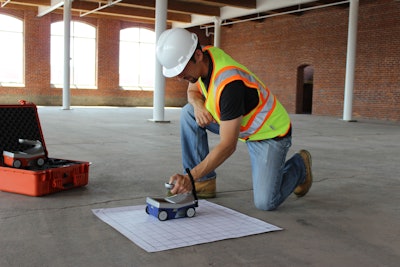Specialist Tips for Ideal Concrete Scanning Results
Specialist Tips for Ideal Concrete Scanning Results
Blog Article
Past the Surface: Leveraging Advanced Concrete Scanning Techniques for Unmatched Precision and Insight
In the world of building and infrastructure upkeep, the mission for accuracy and thoroughness is endless. Advanced concrete scanning techniques have actually arised as important devices in this quest, offering a glance under the surface area to unveil a globe of essential understandings. By utilizing sophisticated technologies, experts can uncover anomalies, examine the condition of concrete frameworks, and make informed choices that shape the program of tasks. The ramifications of these strategies extend far past mere surface-level examinations, assuring a depth of precision and understanding that is unequaled.
Significance of Advanced Concrete Scanning
The value of utilizing advanced concrete scanning techniques depends on the unparalleled precision they use for discovering sub-surface abnormalities and making sure architectural honesty. By using cutting-edge technologies such as ground-penetrating radar (GPR), electromagnetic induction, and advanced sonar imaging, building experts can dig underneath the surface area of concrete frameworks with a degree of precision that much goes beyond typical examination methods. Concrete Scanning. These methods make it possible for the recognition of concealed risks like rebar deterioration, gaps, channels, or post-tension wires that can endanger the security and security of a structure gradually
Moreover, advanced concrete scanning provides indispensable insights into the overall problem of a concrete element without the requirement for invasive measures, minimizing the threat of creating damage throughout the analysis process. The ability to determine the precise area and deepness of prospective problems enables targeted fixings and upkeep, ultimately lengthening the life expectancy of the structure and maximizing its performance. Essentially, the significance of advanced concrete scanning can not be overemphasized in the realm of building and construction and facilities maintenance, where accuracy and integrity are vital.
Types of Cutting-Edge Technologies

Anomalies and Problem Detection

In enhancement to GPR, concrete scanning methods like thermography and impact-echo testing are additionally reliable in finding abnormalities and flaws. By leveraging these advanced strategies, experts can proactively deal with architectural problems, making certain the long life and safety of concrete frameworks.
Assessing Concrete Condition
Just how can engineers precisely evaluate the condition of concrete frameworks to guarantee their longevity and security? Numerous advanced concrete scanning methods are utilized for this purpose. Ground-penetrating radar (GPR) is frequently made use of to assess the interior framework of concrete, spotting spaces, fractures, and various other anomalies that may endanger its toughness.
Furthermore, aesthetic examination continues to be a fundamental part of concrete problem analysis. Engineers visually analyze the surface area for indicators of wear and tear, such as spalling, splitting, or staining. Combining non-destructive testing techniques with aesthetic assessments enables a thorough evaluation of concrete condition, allowing designers to recognize possible concerns early on and execute timely maintenance or repair work. By leveraging these sophisticated strategies, designers can ensure the long-term sturdiness and safety and security of concrete frameworks.
Enhancing Decision-Making Processes
In the see here world of framework monitoring, enhancing decision-making processes is vital for guaranteeing the effective upkeep and longevity of concrete frameworks. Improved decision-making processes in concrete management involve making use of sophisticated scanning techniques to collect detailed information on the condition of structures. By leveraging technologies such as ground-penetrating radar and 3D imaging, stakeholders can make enlightened decisions pertaining to repair service, reinforcement, or replacement techniques.
These progressed scanning techniques supply important understandings right into the internal structure of concrete, identifying prospective concerns such as voids, fractures, or corrosion that may not show up externally. This level of in-depth details enables positive upkeep planning, decreasing the danger of structural failures and raising the overall lifespan of concrete structures.
Moreover, by including digital documentation and analysis tools into the decision-making process, stakeholders can track the evolution of concrete problems with time, making it possible for predictive maintenance techniques and enhancing resource allotment. Eventually, the integration of advanced concrete scanning techniques enhances decision-making processes by offering unrivaled accuracy, insight, and efficiency in framework monitoring.
Final Thought
To conclude, advanced concrete scanning strategies provide unrivaled precision and insight in discovering abnormalities, issues, and examining the problem of concrete structures. By leveraging find out cutting-edge modern technologies, decision-making processes can be enhanced, bring about even more reliable and educated services for maintaining and fixing concrete infrastructure. These techniques play a critical function in making sure the security and longevity of concrete frameworks, making them a vital tool in the area of building and engineering.
Additionally, progressed concrete scanning offers vital insights right into the overall problem of a concrete element without the requirement for invasive steps, reducing the threat of triggering damages during the evaluation procedure - Concrete Scanning. One more cutting-edge technology is 3D X-ray scanning, which provides thorough images of the interior framework of concrete, providing useful details without the requirement for devastating testing. In Addition, Concrete Cover Meters are used to determine the density of concrete cover over reinforcement bars precisely. Boosted decision-making processes in concrete management include utilizing sophisticated scanning techniques to gather thorough data on the condition of frameworks.In conclusion, advanced concrete scanning strategies offer unparalleled accuracy and understanding in identifying anomalies, problems, and examining the problem of concrete frameworks
Report this page